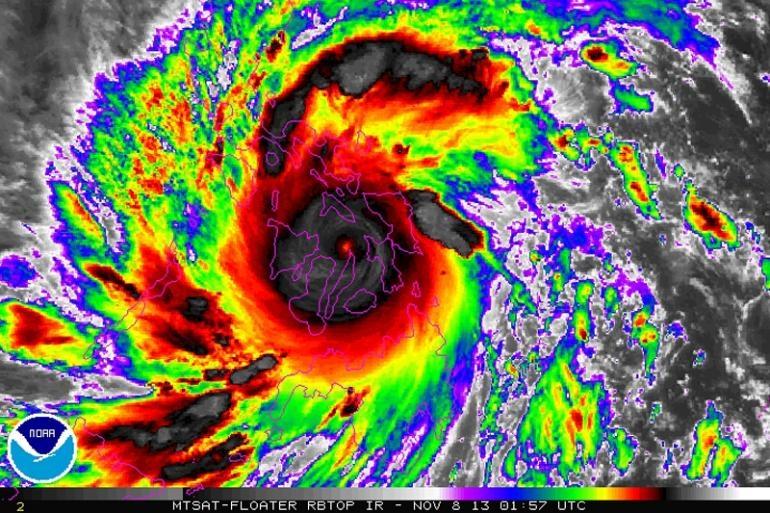
Typhoon Haiyan Can't Erase Chess Culture of Philippines
Recently, the massive Typhoon Haiyan directly hit the Philippines, a country with a rich tradition of chess. The country is easily the strongest island nation in the Pacific, with Australia and Indonesia a distant second and third, respectively. With a dozen active grandmasters and a top-30 world player, the Philippines is behind only China and India as the best chess country in Asia.
The country also has more depth than you might think. The November Elo rating of their 100th-best player is 2122, higher than China's 100th player (2121). Chess.com itself is certainly aware of the game's popularity among Filipinos, as the island ranks fourth in terms of total members per country on our site. The tragedy taking place in the Philippines and the wealth of chess history inspired me to write a piece on the history of chess in their country.
The historic storm, which is known as a typhoon in the Pacific Ocean and a hurricane in the Atlantic Ocean, made landfall on November 7. Haiyan (called Yolanda in the Philippines) had sustained winds of nearly 200 miles per hour. The classification was known as category-5, which is the highest on the scale, and by some estimates this was the most ferocious storm ever to make landfall.
As of this writing, almost 4,000 are confirmed dead, with thousands more missing. Property damage is expected to be in the multi-billions of U.S. Dollars, with the country's economy suffering losses several times that amount.
Coupled with a recent earthquake, the country needs to bolster its infrastructure and provide basic supplies to its people before picking itself up and beginning to heal and rebuild. If you would like to help, please consider making a donation to UNICEF or the Philippine Red Cross.
Below is only a small sampling of how the Philippines has shaped the chess world. Comment below if we missed any of your favorites!
Any retrospective of Filipino chess must begin with the exploits of GM Eugenio Torre, the continent's first grandmaster. He cemented the title in 1974 by also winning an individual bronze medal at the Olympiad in France (going undefeated over 19 games). Two years later, while on home soil, he beat reigning World Champion Anatoly Karpov.
At that Category XV tournament (which featured Karpov, Ljubomir Ljubojevic and Walter Browne), Torre won by 1.5 points even though he was rated last by a long margin.
Torre stayed at the top for quite some time. He played in 19 consecutive Olympiads for his country, with 17 of the them being on board one. He won two more bronze medals. Then after sitting out in 2008, Torre has come back to play in two more. His last appearance, in Istanbul 2012, set the record for most Olympiad appearances (21 - GM Lajos Portisch has 20) and his 149.5 all-time points are the second-highest ever (to Portisch).

Torre as a top-20 player in 1984
Here's a great final position from the 1976 Olympiad in Haifa, Israel. Look at how helpless Torre made his opponent's army:
Chess politics was complicated that year - the Soviet Union and many Eastern bloc countries boycotted since they didn't recognize Israel. Some nations set up an alternate Olympiad in Tripoli, Libya. Chess-crazed Philippines was one of only three nations to send teams to both "Olympiads"!
Torre's fame no doubt helped in bringing the 1992 Olympiad to the capital, Manila. Numerous notable events happened that year, including a newly-independent Russian team winning the first of their six straight team golds. Though only an FM and technically playing as an alternate, Vladimir Kramnik scored an incredible 8.5/9 for a performance rating of 2958 and individual gold.
The famous game Averbakh-Kotov was also resurrected, with GM John Nunn ably channeling his fellow accomplished author:
Later, Torre would also represent the Philippines in several Asian Team and Asian City Championships. In 1992, he seconded Bobby Fischer in his rematch with Boris Spassky. Later this friendship would partially tarnish his image, as he assisted in Fischer's diatribes on Philippine radio. Despite being in his 60s, Torre remains quite active, having played 24 rated games in the last FIDE rating period.
Torre's mantle was passed several years ago when a budding youngster by the name of Wesley So came along. At the age of 15, he became the youngest person ever to pass the 2600 threshold (besting the mark set by a young man named Carlsen). A year later, he won the Corus "C" Group and set the Pinoy all-time record rating of 2627, passing GM Mark Paragua's 2621.

GM Mark Paragua, winning the 2012 Philippine National Championship (often called the "Battle of the Grandmasters") [courtesy Chessdom.com]
Paragua has been at the top of the Philippine's charts for a while, becoming the torchbearer as Torre aged. Look at how he used a bevy of open lines to beat the current world number two:
So's most notable achievement that gave him worldwide notoriety came six months later. At the 2009 FIDE World Cup, he beat sixth-seeded GM Vassily Ivanchuk in the second round, then took out reigning champion GM Gata Kamsky the following round.
So is now the undisputable top player for the Philippines. He has board one firmly locked up at national team events - and in four Olympiads, he has only lost one game, and that was as an FM in 2006. He now attends college in the United States, but that hasn't stopped him from having an incredible 2013 campaign. In just this year he has won or tied for first in the Reykjavik Open, Calgary International, Las Vegas International, World University Championship and Unive Chess Tournament. In January, he will compete in Wijk aan Zee's Tata "A" Group for the first time.

So, after winning this year's Unive (courtesy Lennart Ootes)
Other top players have come out of the Filipino system, including GM Julio Sadorra, who is now number three on the country's rating list. He came to the U.S. on a chess scholarship to the University of Texas - Dallas, and played sparkling chess in the United States Chess League. Last season his performance rating in the USCL was 2869. One of his wins won Game of the Week and was even featured in the New York Times.

GM Julio Sadorra (courtesy uschessleague.com)
Many of the other top players are similarly young. Like Sadorra, the Philippine's number two and four, GM Oliver Barbosa and GM John Paul Gomez, were all born in 1986, solidifying the national team for years to come. In Istanbul, Barbosa beat or drew many 2600s and played 100 points above his rating. All five players outperformed their level, including Paragua.
A complete accounting of the most influential Filipino chess figures would be incomplete without also discussing former FIDE President Florencio Campomanes. Twice a national champion and Ivy League educated, he made his true mark later in the world of chess politics. As president for 13 years, he presided over the controversial decision to abandon the first Karpov-Kasparov match, but also greatly increased FIDE's member nations.

Campomanes in 2008 (photo courtesy karpidis, Creative Commons Attribution 2.0 license)
Previous to his leadership, he helped organize the 1978 Karpov-Korchnoi title match in Baguio City, Philippines (one of the qualifying Interzonals was in Manila). In the first of two grueling title defenses against Korchnoi, Karpov needed a full three months to edge his challenger. The protracted antics and gravitas of the match even created a mention of the Philippine's in the musical Chess - other elements of the musical were likely inspired by the match.
After falling behind 5-2 in the race to six wins, Korchnoi won three out of four before losing the next game, ending the match. This is the penultimate game that evened the score 5-5. Notice the similarities between this and Magnus Carlsen's game six win in the current World Championship Match - the enemy king is hemmed in on the edge by his own pawn as an enemy bishop's pawn races up the board.
The country is also still very much on the FIDE power map, as Kasparov himself just visited this week in his campaign for his own presidency.
Even boxing champion and politician Manny Pacquiao got in on the act recently. Pacquiao is several magnitudes more popular than anyone else in his country, and he lent his name and sponsorshop to this year's Asian Individual Championship. He played a prescribed 20-move game with Torre, which was agreed drawn, perhaps out of sportsmanship.

Torre (left) and Pacquiao (right) at this year's Asian Individual Championship (courtesy Fide.com)
Lastly, the current World Champion Viswanathan Anand also spent a brief period of his formative years in the Philippines. Despite mostly growing up in India, he spent one year in the Philippines, where he claimed to watch a television program devoted to chess. In an interview with GM Susan Polgar, Anand described what happened next:
And there they had a TV program that was on in the afternoon, one to two or something like that, when I was in school. So she would write down all the games that they showed and the puzzles, and in the evening we solved them together.
Of course my mother and her family used to play some chess, and she used to play her younger brother, so she had some background in chess, but she never went to a club or anything like that. So we solved all these puzzles and sent in our answers together. And they gave the prize of a book to the winner.
And over the course of many months, I won so many prizes. At one point they just said take all the books you want, but don't send in any more entries.
Once again, if you wish to support the Philippines in this time of great need, UNICEF and the Philippine's Red Cross are two excellent options.



